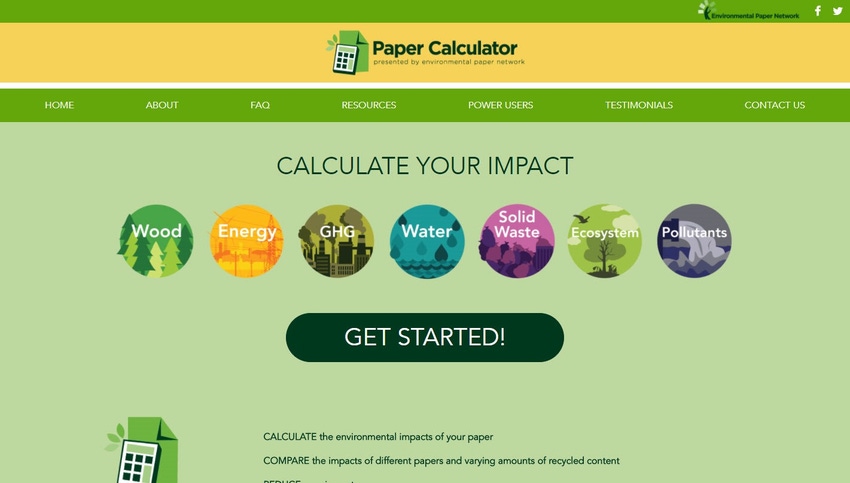Calculator Keeps Environmental Impact of Paper in Check
The Paper Calculator, a free and publicly available web-based resource, allows users to calculate and compare the estimated environmental impacts of different papers and paper choices.

According to the American Forest & Paper Association, 22.4 million tons of paper were landfilled in 2017, and every ton of paper takes up about 3.3 cubic yards of landfill space. While organizations and companies have been successful in reducing these numbers, waste paper still presents a challenge for the waste and recycling industry.
To help tackle the waste paper issue, the Environmental Defense Fund (EDF) created the Paper Calculator in 2005. The Paper Calculator is a free and publicly available web-based resource that allows users to calculate and compare the estimated environmental impacts of different papers and paper choices using lifecycle assessment (LCA). Version 4 of the calculator was released this summer.
The tool was managed by the EDF until 2011, when it transferred to the ownership of the Environmental Paper Network (EPN), a coalition of more than 140 nonprofit organizations working toward the sustainable production and consumption of pulp, paper and packaging.
“It was ahead of its time as it was one of the very first product lifecycle assessment tools, even before LCA was commonly used in the sustainability field,” says Kim Porter, development coordinator and project manager for the EPN, based in Asheville, N.C. “It’s still progressive today because very few LCA tools are free to the public or transparent about the science behind them.”
The scientific basis for the original Paper Calculator’s model was a project that included a detailed analysis by a consortium called the Paper Task Force. The task force was a three-year, multi-stakeholder and multi-sector research project convened by Environmental Defense Fund, Duke University, Johnson & Johnson, McDonald's, Prudential Insurance and Time Inc.
“It resulted in the comprehensive Paper Task Force Report, which was published in 1995, and represented the most complete research effort of its time, assisted by hundreds of experts from diverse perspectives,” says Porter. “The report created the first-ever recommendations for purchasing environmentally preferable paper, and it is still widely respected today as a landmark collaboration, backed by science and executed with the highest level of transparency.”
Today, the Paper Calculator uses a cradle-to-grave lifecycle analysis, which is a science-based process that can be used to assess the environmental impacts associated with the lifecycle of a product, from raw material extraction and processing to the end-of-life phase. The analysis provides a quantified approach for comparing the environmental performance of different sources of fiber.
It allows users to create reports about the wood, water, energy, greenhouse gases, pollutants, solid waste and other ecosystem impacts created by using a specific amount or weight of paper used, or conserved by reducing paper use and better choices.
Partnering with SCS Global Services, a leader in third-party environmental and sustainability certification and standards development, EPN created version 4 of the Paper Calculator in July.
“EPN chose SCS Global Services to guide this important effort because of their expertise in lifecycle assessment, their knowledge of the forest and paper industry and their reputation for thoroughness and quality,” says Porter. “Their broad network of auditors are experts in their fields, and the company is a trusted partner to many environmental nongovernmental organizations due to its dedication to quality and professionalism. Their expertise was invaluable in helping us successfully develop truly useful and fair comparisons of the impacts and sustainability of wood and paper products.”
SCS Global Services completed research to evaluate the lifecycle impact profile of 14 different paper grades produced in North America, including:
Tissue paper
Linerboard
Uncoated freesheet (copy paper)
Coated freesheet (high-end catalog)
Uncoated groundwood (newspaper)
Coated groundwood (magazine)
Corrugated container
Paperboard
The company used a methodology conforming to ISO 14044, the draft LEO-S-002 standard, the Product Category Rule (PCR) for Pulp and Paper, the PCR Module for Roundwood and the LCIA Methodology for Roundwood and Pulp/Paper PCR Modules, according to Keith Killpack, manager of LCA Services for SCS Global Services, based in Emeryville, Calif.
A total of 24 indicators were evaluated including energy, climate change, water, waste, air pollutants and ecosystem impacts. SCS developed an advanced methodology that incorporates data from 300 pulp and paper mills across the U.S. and Canada, drawing from the RISI Mill Asset Database on forest products as well as additional public and private sources.
The new version 4 Paper Calculator reflects a multiyear, multi-stakeholder process by the Environmental Paper Network and SCS Global Services, in consultation with conservation groups including Canopy, Natural Resources Defense Council, National Wildlife Federation, Sierra Club and Conservatree, as well as representatives from academia and business, including the University of Southern California and Kimberly-Clark Corporation.
“Paper Calculator version 4 is the most comprehensive update of this tool to be released and includes new features based on feedback from the thousands of organizations that have used the tool over the past 13 years, including more expansive environmental impact categories such as additional pollutants and new biodiversity and ecosystem impacts, for a total of 24 indicators in all,” says Killpack. “It provides more accurate and updated climate change reporting based on the most recent science, and it has been updated with the latest paper industry and lifecycle assessment data from trusted sources. Additionally, the new Paper Calculator covers an expanded range of paper grades and now includes the growing sector of tissue products.”
Municipal waste and recycling entities use the Paper Calculator as a tool to quantify and publicize the benefits of eco-friendly paper purchasing and paper-saving decisions to their customers, employees, owners, shareholders and communities.
“The results are positive realizations about bringing waste reduction and sustainability into their choices—and positive marketing for any organization,” says Porter. “The Paper Calculator highlights how changes in the way we use paper can add up to make a big difference for the environment. This helps motivate everyone from employees to county leaders to continue to support these efforts. And we all benefit when companies and organizations are making sustainable choices for the planet.”
About the Author(s)
You May Also Like


